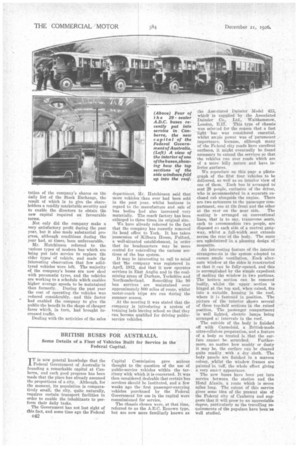BRITISH BUSES FOR AUSTRALIA.
Page 64

If you've noticed an error in this article please click here to report it so we can fix it.
Some Details of a Fleet of Vehicles Built for Service in the Federal Capital.
JP is now general knowledge that the Federal Government of Australia•is founding a remarkable capital at Canberra, and such good progress has been made that the place has already assumed the proportions of a city. Although, for the moment, its population is comparatively small, the city, quite naturally, requires certain transport facilities in order to enable the inhabitants to perform their daily tasks.
The Government has not lost sight of this fact, and some time ago the Federal c42 Capital Commission gave serious thought to the question of the use of Public-service vehicles within the territory with which it is concerned. It was then consideredIdesirable that certain bus services should be instituted, and a few weeks ago the first passenger-carrying vehicles purchased by the Federal Government for use in the capital were commissioned for service.
The chassis chosen were, at that time, referred to as the A.E.C. Renown type, but are now more familiarly known as
the Asscciated Daimler Model 413, which is supplied by the Associated Daimler Co., Ltd., Walthamstow, London, E.17. This type of chassis was selected for the reason that a fast light bus was considered essential, whilst ample power was of paramount importance, because, although many of the Feleral city roads have excellent surfaces, it might eventually be found necessary to extend the services so that the vehicles run over roads which are of a more hilly nature and have inferior surfaces.
We reproduce on this page a photograph of the fil•st four vehicles to be delivered, as well as an interior view of one of them. Each bus is arranged to seat 29 people, exclusive of the driver, who is accommodated in a separate enclosed cab alongside the engine. There are two entrances to the passenger compartment, one at the front and the other at the rear on the near side. The seating is arranged on conventional lines, that is to say, transverse seats, each to sccommodate two people, ere disposed oa each side of a central gangway, whilst a fall-width scat extends across the rear of the body. The seats are upholstered in a pleasing design of moquette.
An interesting feature of the interior arrangements is the system adopted to ensure ample ventilation. Each alternate window at the sides is constructed so that it can be fully opened, and this is accomplished by the simple expedient of making the window in two portions. The bottom section can be removed bodily, whilst the upper section is hinged at the top and, when raised, fits into a suitable housing in the roof, where it is fastened in position. The picture of the interior shows several of these top-half sections in the raised position. The passenger compartment is well lighted, electric lamps being arranged a: intervals in the roof.
The outside of the body is finished off with Carmeloid, a British-made nitro-cellulose preparation, and a feature of a body so treated is that the sur
face cannot be scratched. Furthermore, no matter bow muddy or dusty it may be, the surface can be cleaned quite readily with a dry cloth. The body panels are finished in a maroon colour, „whilst the window frames are painted in .3uff, the whole effect giving a very smaat appearance.
The new buses have been put into service between the station and the Hotel Ainslie, a route which is seven miles long. The extent of this service gives some idea of the present size of the Federal city of Canberra and suggests that it will grow to an appreciable degree, particularly as the travelling requirements of the populace have been so well studied.












































































































